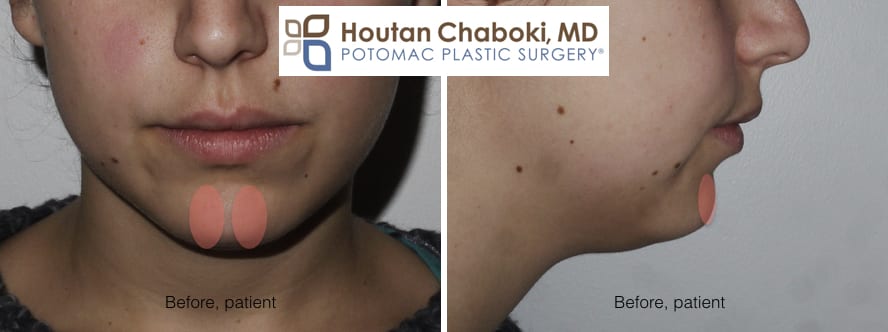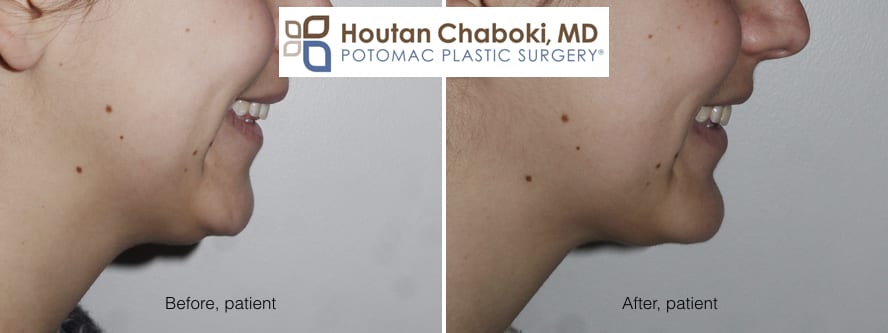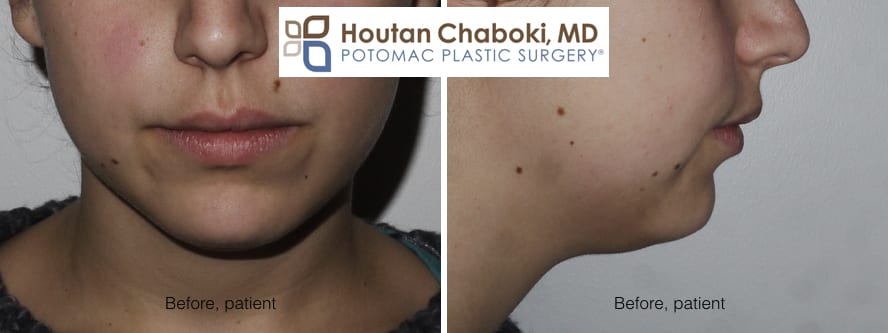Patients who complain of a double chin or a weak chin are common in a facial cosmetic surgery practice. There are many reasons why one may have a weak chin. These patients may have been born with a weak chin or a double chin may gradually occur over time. For example, those with an overbite are predisposed to a double chin or weak chin. As with many aspects of plastic surgery, anatomic considerations are very important.
One anatomic aspect of chin surgery that plastic surgeons consider is the mentalis muscle.
What is the mentalis muscle?

Before chin and neck surgery for a double chin. Approximate location of mentalis muscle in pink.
The mentalis muscle is located in the chin. It typically extends from the bottom of the central chin to the depressed groove under the lower lip. Patients have a mentalis muscle on each side of the chin in this area, with a small gap in the middle. The mentalis muscle elevates the lower lip and contributes to pouting of the lips
Patients who are born with a weak chin or have an overbite may have strain in the mentalis muscle and/or lower lip incompetence. The chin may be dimpled from this muscle strain, and the lips tend to be open.
Sometimes the mentalis muscle is not attached to the lower chin bone, either congenitally or from prior jaw surgery, as a result, it’s in a higher position than typical. A high-riding mentalis muscle may give the chin a more blunted appearance when viewed in profile or more “button” or ball-like appearance on front view.
What is the role of the mentalis muscle in chin surgery?
Unlike neck lift surgery where the muscle may be lifted or tightened, during chin surgery, the mentalis muscle is preserved. Plastic surgeons don’t remove this muscle as part of chin implant surgery. Chin implants, whether placed through a small incision under the chin or inside the mouth, are placed deep or under the mentalis muscle. The chin implant is placed onto of bone and the mentalis muscle slides over the implant. Initially after chin surgery, the chin area or muscle may feel “tight” and gradually resolves with time.
Treatment options for a weak chin
A hyperactive, strained mentalis muscle can be temporarily relaxed with Botox® or Dysport® injections to help smooth a dimpled chin. Some plastic surgeons and dermatologists refer to this muscle tension appearance as peau d’orange appearing chin. Anywhere from approximately 5-20 units of Botox may be given to relax the mentalis muscle and improve the appearance of the chin. Botox and Dysport can be given before and/or after chin surgery as appropriate.

Before and after chin and neck surgery for a double chin. A medium silicone implant was placed via a small incision under the chin. Neck liposuction was also performed to enhance the neck lift result.
Plastic surgery is a common approach to enhance the chin. Chin augmentation with a silicone implant is the most popular method. Chin implant can be performed alone or combined with other procedures such as neck liposuction to provide better definition of the jawline, chin, and neck. As a result, the neck can be lifted with chin surgery alone. More advanced double chins with skin laxity or loose neck muscle may need a lower facelift or neck lift surgery. Read more about chin implant surgery and neck liposuction for a double chin.
Have your considered chin surgery? Contact the office and schedule a consultation.


Leave a Reply